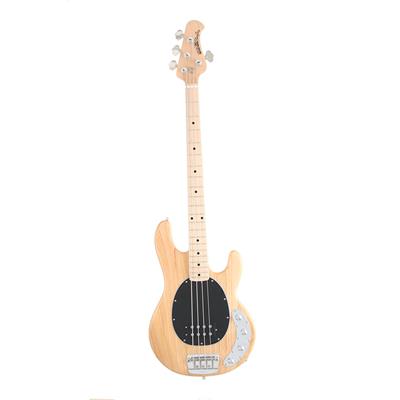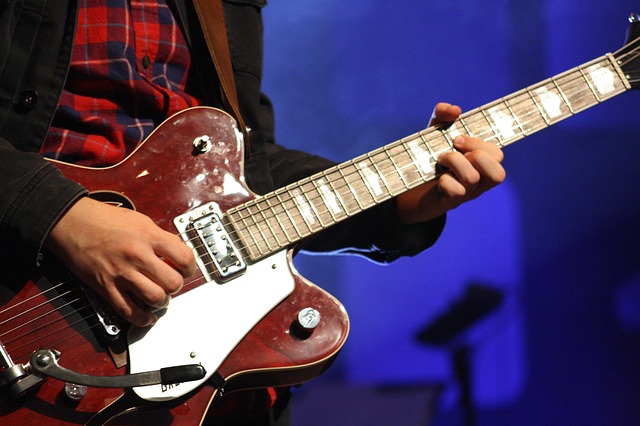All of us who take guitar playing seriously get to the point in our lives and career where we feel the need to start recording. It doesn’t happen because we become overambitious or overconfident, it’s because we understand our music and the creativity flows effortlessly. We reach the level of craftsmanship that enables us to write new pieces and eventually start recording them on our computers or dedicated equipment.
You might know all the gear that you’ll need for that purpose, but you might not know that you need a mic to capture the true essence of your amp and sound. More often than not you’ll see guitarists using that technique because it helps them retain the full character of their layered tone (which would be lost otherwise). A mic can be used for diverse purposes: for vocals, keyboards, and any other instrument. Today we’ll focus on the selection of the best mic for the guitar amp, but that doesn’t mean the chosen one won’t have any other applications. Let’s talk about that later, since now it’s time to get this journey started!
What’s The Best Mic for Guitar Amp
| Image | Amplifier Model | ||
|---|---|---|---|
 | Shure SM-57 Cardioid Dynamic Microphone |  (4.8 / 5) (4.8 / 5) | Check on Amazon |
 | Sennheiser MD 421 Dynamic Mic |  (4.8 / 5) (4.8 / 5) | Check on Amazon |
 | Royer Labs R-121 Large-Element Ribbon Microphone |  (4.7 / 5) (4.7 / 5) | Check on Amazon |
 | AKG C414 XLS Large Diaphragm Condenser Microphone |  (4.7 / 5) (4.7 / 5) | Check on Amazon |
 | Sennheiser E906 Supercardioid Dynamic Mic |  (4.6 / 5) (4.6 / 5) | Check on Amazon |
Shure SM-57 Cardioid Dynamic Microphone
| Features: |  |
| Controls: |  |
| Sound: |  |
| Value: |  |
| Average: |  |

You know that you need good speakers for your amp to sound good, right? Well, it’s the same pattern with mics – they should have decent quality in order to retain the authenticity of your tone. A cheap (and I mean quality-wise) model is likely to lose those details and that’s not something you want to hear on your recording. That’s why it’s a good idea to go for something like Shure SM-57. It offers high-quality performance, in other words, it has the capability to save the original properties in your music. It can be utilized on stage with your instruments or in the studio for recording – you can even use it for your vocals.
However, if you notice some flaws with the latter application, you shouldn’t be surprised. After all, it’s built with instruments in mind. SM-57 will mic your sound without amplifying the noise, which can be really useful if you aren’t in a completely quiet space. One of the biggest virtues of this fella is that it’s built like a tank. You can drag it from one place to another interminably and it will still handle all the abuse. Even though you have to crank up your amp to achieve loud results, the quality of sound is impeccable.
Pros:
- Built like a tank
- Dynamic sound
- Can handle a wide variety of instruments
Cons:
- Doesn’t have a lot of gain
Sennheiser MD 421 Dynamic Mic
| Features: |  |
| Controls: |  |
| Sound: |  |
| Value: |  |
| Average: |  |

If money isn’t a problem for you and you’re willing to invest in a magical piece, then Sennheiser MD 421-II is the best option. It’s a mic that is virtually flawless – you won’t even find any flaws other than its bigger size. It’s a model that can be an ultimate purchase because the chances are you won’t need anything else unless it breaks (which isn’t going to happen). This puppy has a frequency response of 30 – 17000 Hz, enabling you to amplify low-end as much as your heart desires. With the help of its five-position bass roll-off switch, you can easily tame those basses and focus on the mid-range or trebles.
Even these features are enough for MD 421-II to be the best mic for the guitar amp. But there’s more. It filters out any noise, which means that your recording won’t be jammed with traffic honks, construction chaos, and straight-up buzz. It will amplify the sound of your amp clearly and transparently. More importantly, it can have numerous applications, turning it into an extremely versatile piece. I’d say just go for it!
Pros:
- Versatile
- Cancels out any noise perfectly
- Clear tone with a lot of gain
Cons:
- A bit large
Royer Labs R-121 Large-Element Ribbon Microphone
| Features: |  |
| Controls: |  |
| Sound: |  |
| Value: |  |
| Average: |  |

This one is definitely not for beginners, since it’s an expensive treat. And when I say expensive, I mean it. It could cost more than your whole gear together, and if that’s the case, maybe you should update those first before splurging on this one. However, it certainly isn’t overpriced. The quality that you’ll experience with Royer Labs R-121 will be something you’ve never felt before. Once you plug your amp and pair it with this mic, you’ll immediately notice how your sound goes from 0 to 100.
It can handle any volume without getting distorted, enabling you to jam as loud as you want. The brand redesigned ribbon microphones and tailored them to modern needs. This puppy features their proprietary offset ribbon transducer, which is located closer to the front. This way there’s more space for it to move in the magnetic field, resulting in a fuller and richer frequency response. R-121 has low residual noise, clear and transparent sound and power that we don’t really see that often. In brief, it’s a mic that you should purchase if the quality of tone is your priority!
Pros:
- High quality construction
- Impeccable sonic reproduction
- Clear, noiseless operation
Cons:
- Quite expensive
AKG C414 XLS Large Diaphragm Condenser Microphone
| Features: |  |
| Controls: |  |
| Sound: |  |
| Value: |  |
| Average: |  |

Some mics are more ordinary than others, while some are truly legendary. AKG C414 XLS belongs to the category since this model has been a reliable tool for various musicians for 50 years already. It’s based on the original, but it has certain improvements in order to satisfy the contemporary needs of modern players. Though these changes are positive, there’s one inconvenience in the form of digital switching. You see, this fella enables you to choose between 5 polar patterns: Cardioid, Figure of eight, Hypercardioid, Omnidirectional and Wide Cardioid. But in order to select the desired one, you have to phantom power the mic, which can be a bit uncomfortable for many.
It’s also easy to change those settings accidentally and end up with something completely different in the end. On the positive side, C414 XLS remembers the presets and settings, meaning that you don’t have to mess around with them each time you use the mic. The sonic quality is superb and I’m sure you understand just how versatile this puppy is. If you want to get studio-quality results, then you should be willing to pay extra and go through some inconvenience. After all, the best mic for a guitar amp usually comes at a certain cost!
Pros:
- Extremely versatile
- Can have different applications
- Wonderful performance
Cons:
- Digital switching for the patterns
Sennheiser E906 Supercardioid Dynamic Mic
| Features: |  |
| Controls: |  |
| Sound: |  |
| Value: |  |
| Average: |  |

If you want to purchase something that is profiled as a guitar amp mic, then Sennheiser e 906 is the best option you can get for the price. Not only is it transparent and clear, but it also comes with a switch that enables you to choose between three modes. Bright, Moderate, and Dark settings can be used to tailor its response to your gear or instruments, enabling you to reproduce the sound in its perfect shape. This fella has the ability to cancel out noise and pick up only “needed” tones.
It has a flat shape which is extremely useful for amps. Whether you hang it or put it on a stand, it’s quite easy to position it correctly. Due to its character, e 906 might not be suitable for vocals, but I don’t think we should be asking that from a model that’s marketed as an instrument mic. Keep in mind that it has a super-cardioid polar pattern, which is quite sensitive to movements. Choose the angle carefully and you’ll be left with jaw-dropping results.
Pros:
- Easy to position correctly due to the flat shape
- Small and compact design that can be hung
- Amazing sound quality
Cons:
- Not suitable for vocals (it’s not supposed to be, but still good to know)
- Due to its polar pattern, even minor changes in position can affect your sound dramatically
All About Microphone Polar Patterns
If you’ve never had a mic before and it’s the first time you actually started looking for them, the chances are you’ve no idea what the hell is polar patterns. You’ll see these two words in every description, but since manufacturers assume that you know what you’re going for, they rarely explain what they are and why they matter. It’s important to make a reasonable decision, and for that, you need to have some necessary information. So let me explain everything with simple words and show you how to choose the best mic for guitar amp depending on the polar patterns.
To put it simply, a polar pattern is a ball surrounding the capsule. It’s the most sensitive part of the microphone. In other words, that space is the tool for it to pick up sounds. A polar pattern defines what shape that “ball” will have. Depending on that, you’ll get dramatically different results. If the mic can pick up sounds from all directions, it might also reproduce noise and be susceptible to feedback. On the contrary, a model that is sensitive only in a certain area can be way more precise. It’s a bit hard to explain without getting specific, so let’s dig deeper and discuss the most common types of polar patterns that you’ll encounter these days.
Cardioid
A cardioid pattern belongs to the directional microphones. The name stems from its shape (resembles heart) and characteristics. This type of mic is the most sensitive from the front (0˚), it’s completely insensitive from behind (180˚) and more or less sensitive from the sides (90˚/270˚). You should pay a lot of attention to the positioning of such mics since the angle makes all the difference. Place it with 180˚ and you’ll hear nothing – and if you don’t have information about that, you might think that you were given a crappy model.
A cardioid polar pattern is the one you’ve seen the most in our list of best mic for guitar amp. The reason is simple: due to the narrower pickup, they can be directed precisely to the amp, making sure that no other noise or sound will be amplified. Such mics are resistant to feedback and can even be used on large stages. You’ll encounter super-cardioid and hyper-cardioid polar patterns as well. They are similar to the cardioid, but their pickups are even narrower.
Figure-of-eight
The best way to describe the figure-of-eight pattern is to think of the shape of 8 (duh). Once you do that, you’ll understand that such mics are the most sensitive from the front and back. They pick up virtually no sound from sides, enabling you to record two sounds simultaneously. They can be really handy in many applications and they might not be your primary choice as a guitarist, however, they can yield fantastic results if you think about their stereo potential.
Omnidirectional
The easiest pattern to understand is omnidirectional. Remember how I mentioned a ball while defining a polar pattern? Well, this is the type that is literally shaped like a ball. In practice, that means that it can pick up sound from every direction. It’s also susceptible to feedback. What does that mean for guitar players? That means that apart from amp, your mic will reproduce all the existing sound.
It’s always up to you which shape you choose, however, I would suggest going for cardioid (or one of its types). That way you’ll make sure that the recorded sound is as clear and transparent as possible.
Conclusion
I’m guilty of ignoring the necessity of microphones myself. If you’d asked me a couple of years ago whether I liked them or not, I would say that they are useless devices. But as time passed by and I started to understand my tone better, I figured out just how much I needed them. If you have never played with them before, I strongly suggest picking out your favorite one from our list and giving it a shot. The difference you’ll see will literally blow your mind, and I’m not even exaggerating. Be it for stage or for recording purposes, you absolutely need the best mic for guitar amp. Take a look at the options you have, make a purchase and let purity pour into your life. Good luck!






